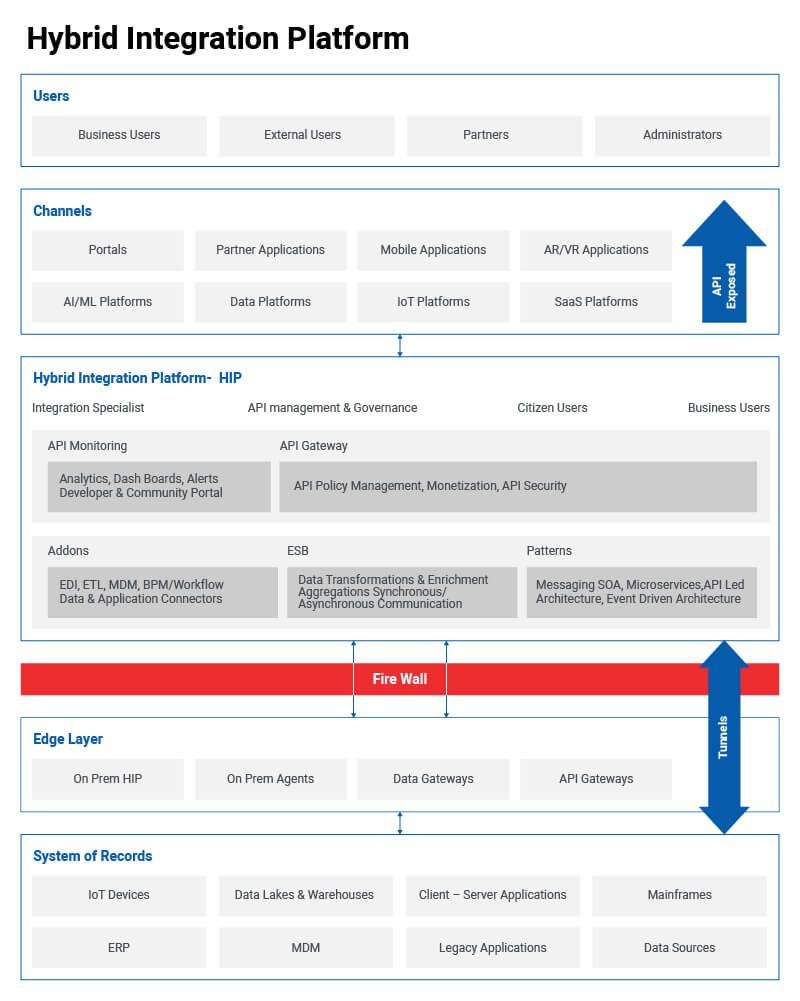What is Hybrid Integration?
As emerging technologies like cloud, AI/ML and IoT continue to reshape customer experience, enterprises are driving towards maximizing their data and technology prowess. The awareness regarding the benefits of cloud is definitely increasing. However, owing to mission-critical workloads hosted in an on-premise environment and massive existing investments, organizations look for a solution that allows them to reap the benefits of cloud while retaining a part of their on-premise infrastructure. This is where Hybrid Integration comes in. It enables the co-existence of on-premise and cloud enterprise systems and applications, unifying it as one operational environment.
The Need for Hybrid Integration
Gartner says that businesses need to be fit for the upcoming challenges and competitions. This is proved in the current Covid-19 situation. Only 20 % of businesses are equipped to take these types of challenges. In order to be relevant, the businesses are adopting multi-level digital transformation strategies. The key objectives are to improve the customer experience, deliver innovation at a greater speed and reduce the bottom line. Cloud, SaaS, AI and IoT based solutions are enabling most of the digital transformation initiatives. It is important to unlock data from the existing system of records and make it available in real-time to power innovative solutions for business-critical decisions.
Understanding the digitization opportunities in key domain specific areas:
- The health care industry is moving towards the digital-first strategy. It is flipping today’s in-person-centric healthcare delivery model. Several complex diagnostic procedures can be carried out at home via ingestible sensors or on-body devices. Wearable fitness trackers can enable health monitoring in the future.
The insurance industry is unlocking data from the legacy mainframe systems for partners to provide digital experience to their customers. - The retail industry is aiming to monitor and control energy consumption, bring out predictive fault detection, minimize the emission of CO2 and control lighting using the IoT and cloud-based analytics platforms in their chain of stores.
- The banks are offering end-to-end digital experience with services delivered through innovative and integrated products accessed through apps from smart phones.
All these innovations are made possible with connected information at real-time across cloud and on-premise systems and devices. In some cases, the organization policies for security concerns restrict moving the data to cloud. However, it is essential to share value added information with the business partners and their customers. Hybrid integration is the seamless and secure integration of on-premises applications with cloud-based apps.
Hybrid Integration Platforms (HIP)
The hybrid integrations are enabled through Hybrid Integration Platforms (HIP).
HIP addresses large enterprise integration needs. The HIP capabilities encompass iPaaS features such as cloud-based integrations enabled with no code abilities for citizens and connectors. This also covers B2B integration, IoT integration, connectors to on-premises applications and API management.
The below diagram demonstrates the HIP capability:

“By 2022, Gartner predicts at least 65% of large organizations will have implemented HIP to power their digital transformation”.
Strategies to Implement HIP
While developing the strategy of implementation, it is imperative to be aware of your current integration capabilities, existing integration solutions, middleware platforms and type of integration patterns such as B2B/EDI and APIs.
The next important focus should be on the business plan and need of the connectivity. Depending on the visibility, you may consider planning for appropriate duration. The implementation plans will be evolving and will change as per the change in business demands. Hence, choosing a future-proof solution with the ability of hybrid integrations is advisable. Once this is done, plan the method of evaluation.
Conclusion
Connecting your partners and exchanging the information across the on-premises and cloud-based applications are key to agility in a competitive business landscape. The API management platforms are inadequate in connecting on-premise and cloud- based systems, implementing large scale B2B integrations and capturing IoT data. Hence, the hybrid integration platforms are inevitable. It is important to devise the correct strategy for choosing the HIP. Once you choose the right HIP, you must plan the resources to carve your digital transformation path.
It is important to periodically assess and analyze the value delivered. Basis the feedbacks, it is imperative to keep improving and updating the capabilities. This will keep your business equipped for countering most of the challenges.
Check out our Hybrid Integration offering to know more.



















